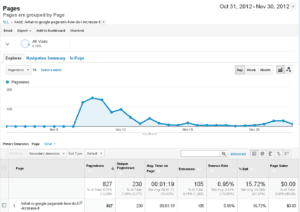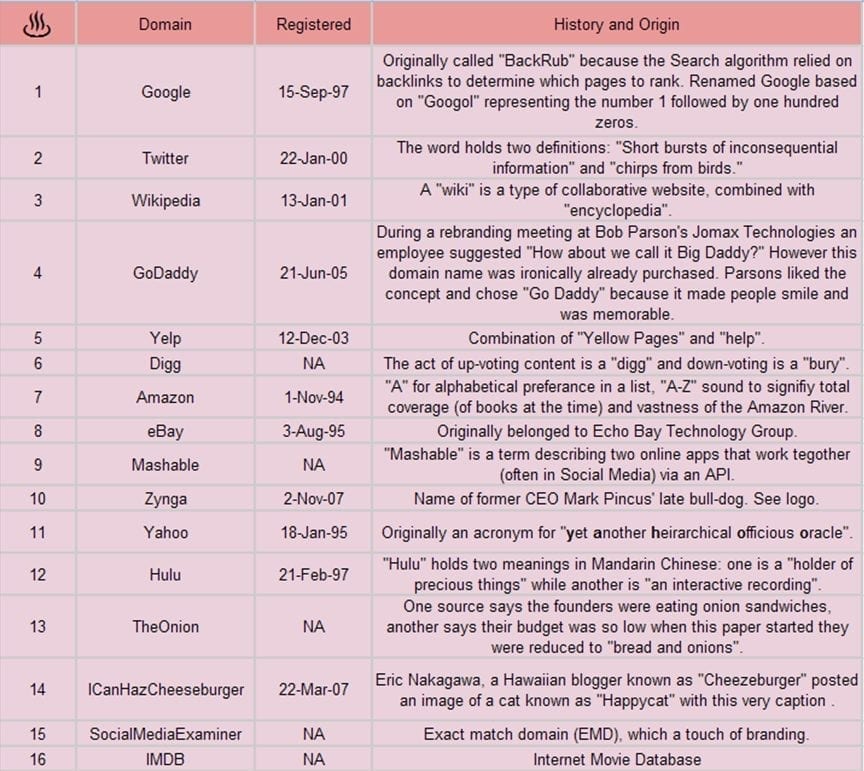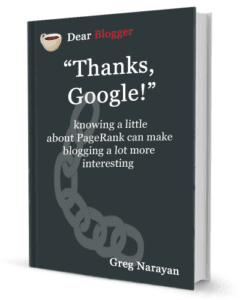I’m back, with a twist.
…and I hope it’s a good one. If you can name it later on I’ll be impressed – there’s actually a lot going on in this post.
…
To kick off this blogpost, I want you to do a favor for me:
Subscribe. Share this post on Google Plus. Make me a hot coffee.
All you have to do is Google “best domain names” and tell me what you find.
Just do it. It may not seem like there’s a problem going on in the SEPRs but as you’ll see below there very much is.
Time to help out ol’ Google

If there’s one thing I’ve realized lately around Google and especially when reading the SEO posts at ViperChill it’s that there still exists a lot of holes in Google.
Holes? Yes, places where there should be more accurate content, or should be content period.
“Best domain names” is an incredibly hot Search, yet the results say nothing about the best domain names on the web.
Problem? Yes. Answer from Dear Blogger? Of course. Google’s amazing. I often Google long tail gibberish only I could possibly understand like “2004 Digg feature Business Week quote about blogging future” and Google fetches it. But in this case we only get advice on how to make a good domain name from our friends at Moz, Lifehacker, and DailyBlogTips.
This advice is okay, but it isn’t inspiring – it tell us all these criteria we have to meet and it’s limiting. All the advice reminds me of the kid who creates a heart for his valentine and whittles it around the edges so much there’s nothing left at all.
So, I did scratched my head and did a few nights of research to make this for you:
16 outstanding domain names and their brief stories
This shows how mega-brands you might love have used pet names, food, lexical genius, made-up actions, foreign languages and more to create memorable domain names and hopefully blows your mind open on how to create a domain name. Plus, I think it’s good blogging trivia knowledge! Please click to enlarge.
For folks starting up a blog, I hope this gives you a much more complete idea of how you can brainstorm your new domain name. As I’ve always said, this should be 100% totally fun.
It’s really not as much about SEO, keywords, and branding as experts will tell you. These things can give you an edge over other blogs, but there’s SO much more out there to draw from that will leave an actual lasting impression on readers.
Notes: Big thanks to whois.net for the dates, the NAs were probably a result of me abusing their search feature. Whois is a tool you might find handy for a ton of domain name related purposes. Sorry if the image is too small within this post, you can click to enlarge of course.
Proof that I’m not (that) lazy
Update: Book is now live at our bookstore, new cover though.
If you haven’t noticed quite yet this post is trying not to preach blogging advice so much as to provide rich, fast, tips with a splash of what I’ve been up to lately.
And speaking of domains, I recently acquired this one: www.pagerankbook.com
Take a moment to check it out, and believe it – some big names are scribing their thoughts here, though all except for Mr. Allsopp are fairly lethargic with email responses 🙂
So, how and why did I pick this domain name for my eBook launch page. More importantly what should you consider next time you create an eBook launch page?
1) Had to be off this blog because that’ll give me more PageRank juice and won’t make any announcement of the eBook get burried by more content. I want this thing to be prolific.
2) “Book” instead of “eBook” because even though eBooks are a phenomenal, cornerstone vehicle for us bloggers to deliver value some folks still consider them cheap or even spammy (like my colleagues who make their fortunes in music then one day start blogs thinking it’s easy, and scoff at the concept of electronic-books).
I’d obviously like for this book to be sold someday at Barnes and Nobles, before they go totally bankrupt of course.
3) Needed “PageRank” in there to help SEO, prett-t-t-ty simple.
Should also note, there are a few different tag phrases up in the air which my authors and I are considering. I’d love your input on any of these.
– “Knowing a little about PageRank can make blogging a lot more interesting”
– “Google: Ya’ll are alright”
– “How I accidentally solved PageRank”
– “Is this the only thing in blogging that lasts forever?”
Let us know, apparently we’re not that good afterall at being catchy…
Here’s a sneak peak…
Introduction and Hello
What is PageRank?
PageRank is a number between 1-10 which Google uses to rank the relevance of any webpage, like your blog post articles, for example. It’s still the leading factor in determining how close to the #1 results your content ranks, and probably won’t go away anytime soon.
Before you begin building PageRank…
You need to have something to say. Google is incredibly smart these days when it comes to distinguishing a healthy resource from a phony one. So, while you could build PageRank around a site with weak content and could still rank well (many sites still do even in this era) your efforts will be exponentially greater if you actually create valuable content. You know what this means…
The best ways to build PageRank…
Will be discussed in this 20-page PDF ebook. That not only includes white-hat link-building practices, simple ways to make your blog easily crawlable by Google’s bots and thus quickly indexed, how to find good topics in your niche that will rank, but some other aspects of this algorithm only discussed in the loftiest circles of blogging. I thought it’d be neat to fill you in on the events that lead up to PageRank, how it actually works (in contexts simple enough that a 4th grader could understand it), some insider strategies (via short case studies) that will help you build it on your blog or website as easily as you’d craft a new recipe for dinner.
Make sure to read the whole book. Unlike my previous eBook, parts of this one may not make sense without the previous explanation. We’ve worked hours to make this concise and digestible, so take a day off, pop some fresh grinds in the machine for a brew, and sit back as you learn everything it takes to elevate to intermediate PageRank and use Google to your every day advantage.
Chapter 2: 10,000 Pageviews in 3 Months
Imagine writing a blog post that got 10,000 or even 20,000 hits within your first 6 months. How excited would you be? You’d probably share this tidbit with your friends, family, and everyone on your blog!
But…assuming you don’t hit the front page of Reddit or get featured in The New York Times, how does one accomplish this?
Simple: backlinks. Or, more specifically, one backlink at the right time. Let’s look at an example pretty similar to the top post in Chart II-1 below, which benefited big time from the PageRank update that passed in the wee hours of Wednesday, November 7th, 2012.

Example: Write post today. Get a backlink pointing to it tomorrow. Two weeks from now, PageRank update passes.
The exact timeframes can of course vary but the thing to focus on here is that an update taking place after a post of yours is published and linked to means big things.

This screenshot reveals how Google, and the rest of the world, noticed the first article I ever wrote on PageRank right at the time of the update. You can see the traffic spike right when Google hit the big blue button at their headquarters. Clearly, the update had helped, to the tune of about 100-150 post views a day.
Over the next few weeks, these post views only added up but that wasn’t all. As the post gained traction, it become more relevant, and more readers started visiting. When I looked at things like subscribers and affiliate commissions, many of them were in fact coming in through that very post.
So, how do you make sure that one update has the greatest possible effect? And where do backlinks even come from? How can you replicate this effect?
Feel free to sign up to the (lately, rather casual) Dear Blogger email list to know exactly when the new eBook comes out in full. Promise it won’t be too much longer, though there may be snow on the ground when it comes out.
Running multiple domains and blogs
A few of you have asked me “what’s it like running multiple domain names and blogs?” in the past few months.
Great question. Before I answer, here’s a look at a few domain names I do run at the moment. This is actually the first time I’m revealing this information. It’s a new and improved transparent effort to help your blogging, so please, pretty-please don’t hack them 🙂
♨ www.dearblogger.org
♨ www.honestcollege.com
♨ www.nyc.gov/mocs
♨ www.chrisokonski.com
♨ www.pagerankbook.com
…three more that other’s would absolutely judo-kick me for listing
♨ www.sanesexysingles.com
So, how does this whole juggling of domain names thing work?
First off, having several online businesses is a pretty awesome feeling. When one of my blogs isn’t getting attention I still get 10-20 emails regarding the other blog – some of which are all “advertise with us” and that’s kind of nice when you live in a city like New York that sucks $20 out of your pocket just for leaving your apartment.
Secondly, it takes a lot of “good is beautifulism.” Good is beautiful is a phrase you might here prolific business people and multi-taskers say to represent how they quickly finish a project and move on to another. If you can own this phrase, you’ll find less stress, more productivity, and more growth in the businesses you love. I’m only just started to realize this…
You need a custom email address
Note: I thought I’d include a section here on creating a unique email address to match your domain name. I know this looks like just a bunch of random words below and I’ll hopefully make a video on the process soon and embed it. In the meanwhile, setting up a unique email resembling your domain name is the first thing you should do after you setup your self-hosted blog. Your brand doesn’t need a ton, but it needs this!
And if you do have your own domain name and web hosting there’s a good chance you can setup a unique email address via your web host.
Like studyHQ AT dearblogger DOT org, which is the new email I setup for really urgent (like your blog is nearing graveyard status) blogging questions. If you haven’t setup some decent web hosting for your blog at HostGator (who I STRONGLY recommend) it’s a good idea to do so.
Then, you can follow these steps to setup a unique email address. This is the kind of process that’s totally impossible to explain in conversation and can make our minds go blah. However, once you do it this becomes easy. Ask away with any questions in the comments.
How to setup a unique email address at HostGator:
- Log in to the cPanel
- In Mail click on Email Accounts
- Enter your new email with the right domain extension following the @
- Create password (necessary but you’ll never use this)
- Click create accountThat’s the easy part…
- Back in mail, click Forwarders
- Add new
- Type in the address you just made
- Add forwarderOk, it gets a bit more complex, but not much!
- Now head to Gmail (I’ll assume this is your email mothership)
- Click on the settings icon
- Click accounts
- Add another
- Enter email you created
- Next
- Next
- Now, send a verification through HostGator to your Gmail. Keep the window open as you grab that code from your inbox.
- Confirm, and boom. You’ve got your own domain name branded email address!
Now, do as I’ve done and create 14 different emails for every single purpose you can think of, like ads, welcomes, byes, blogs, freelancing, and more.
So, what’s the deal with those nameservers?
Lastly, no post on domain names would be complete with a little jabber on one thing that always trips us up at first: nameservers.
Nameservers need to be reset if you register your domain name at a different place from your blog hosting, and that’s about all we need to know.
But, what you should know, is that a nameserver is actually a really cool protocal that converts some sort of usually numeric computer code into something humans can recognize, like a domain name, and tells every single computer web browser that sees that domain name where it should take the user.
Lots of serving!
Conclusion: The usual discussion
I’ll obviously admit this is the first post in weeks here but I hope you enjoyed the transparent approach and the insight I tried to provide so that you can create an domain name that really turns heads. Your dream domain name is still available, you just have to find it, and once you do, start thinking about how you can scale your business upwards with multiple domain names and the use of PageRank.
I’ll stick around for a bit to chat, so post your thoughts!








Hi Greg,
Wow , I’ve been wanting to launch my blog ever so long,but I stumble every time,internet has only confused but thank God I finely got hands on your site ,I’m sure every article of yours has answers stored for lost people like me, This article helped understand that yes it not late to get a good domain name
Thanx a ton
Hi Greg,
I am a newbee and old enough to be your Mom 🙂 and I appreciate the clear and conciseness of your instructions. I want to start this but have been dragging my feet until now.
Please explain why I would need so many emails for everything under the sun. Also, not clear just what a ‘nameserver’ is.
Thanks Greg
Hi Joyce!
I would be glad to help you get started. If you mean the personal email and my guide to that – it’s just good for networking emails you might send, and especially nice if you post an email on your site.
You need to know about nameservers if you register your domain somewhere like GoDaddy, then get hosting space from HostGator. All they really are, are two numbers you need to plug in.
Let me know on more!
Very interesting article about keywords and the big names online. Thank you
Thanks Joe. Interesting how few of those domain names had keywords eh.
Interesting how that list of domain names were all unique brand words and none contained keywords. Most people registering domain names seem to cram a few keywords into their domain in the hope that it will improve their SEO.
Exactly! Hurts the brand to SEO cram. Then there’s the belief that all good domain names are taken…
Hey Greg, you are awesome dude…………….. I really like all your post they are helpful in either way to the visitors…………… Great work!
Thanks Neu! Just trying to hit old topics from an exciting angle!
Greg,
the del tag is not closed properly. Everything after that appears as strikethrough text. Can’t read it!
Amazing catch! Bet that looked silly 🙂 On Chrome two open tags worked fine!
hmmm .. great post.
btw waiting for your new ebook launch (and for Google’s next PR update as well) ! 🙂
Whoa!
I thought it would be a boring domain name article, but I was wrong. You picked Problogger idea on domain and even the ebook design 😉
Yo Shahzad,
Well, guess like they say great minds think alike 🙂 Also, I really like the idea of subscribing for a sample chapter, so I set that up in Aweber. Try it out for fun.
I’ll be kind of curious to see if this page gets PageRank when the next update passes. Probably won’t be much more than a 1-2 though. It’s cool how a really small amount of links can dish out good PageRank, huh. Love this aspect of blogging!
Cheers,
Blogger